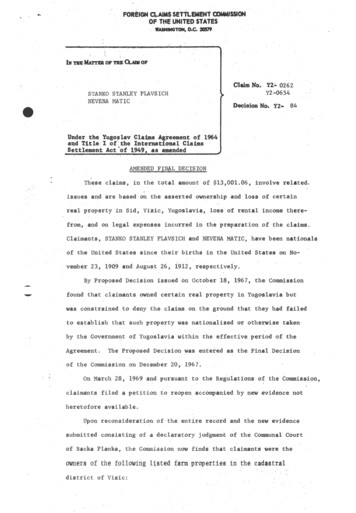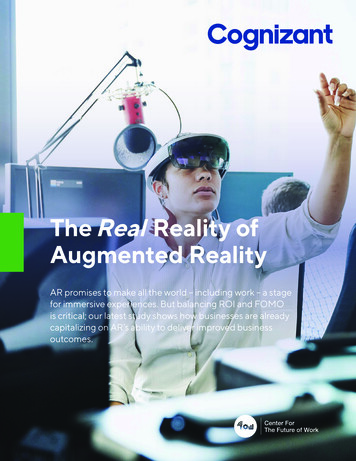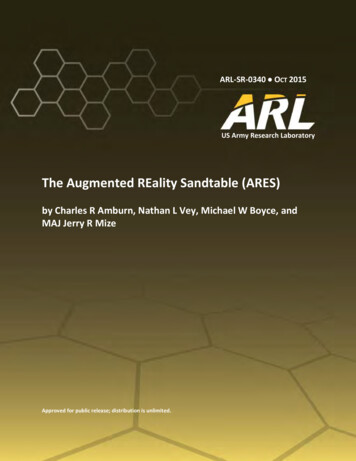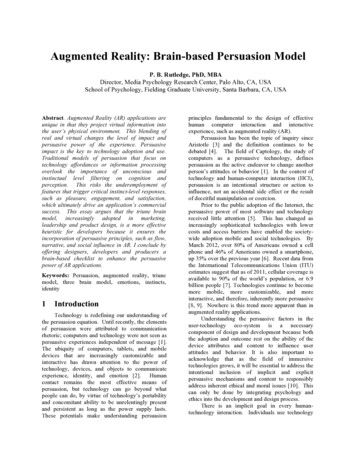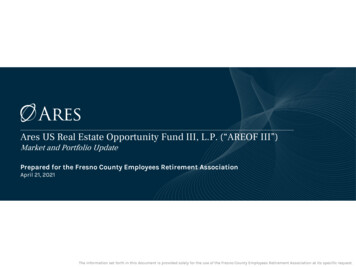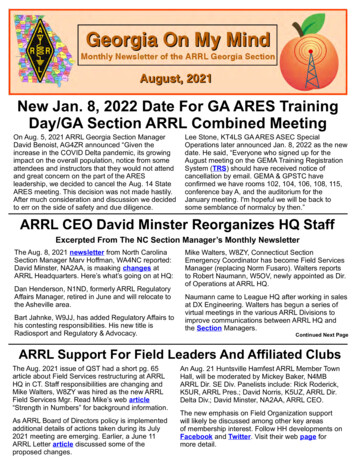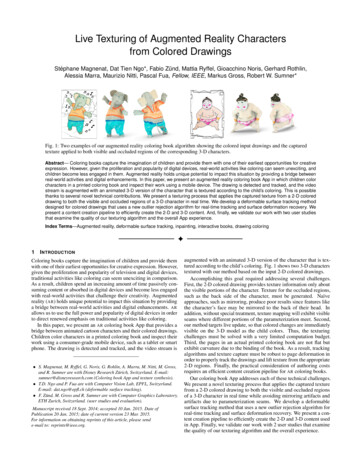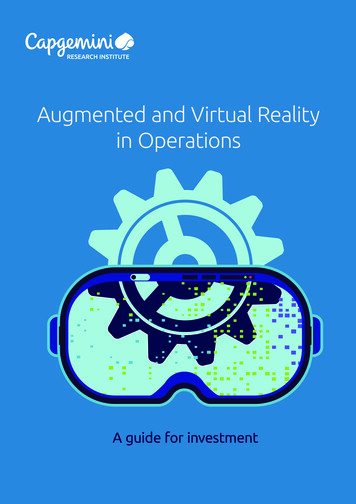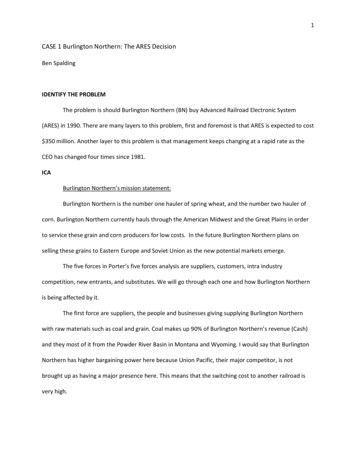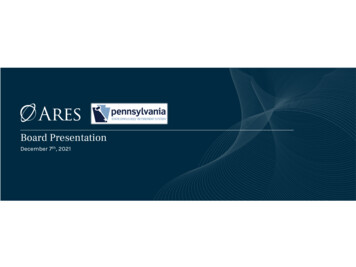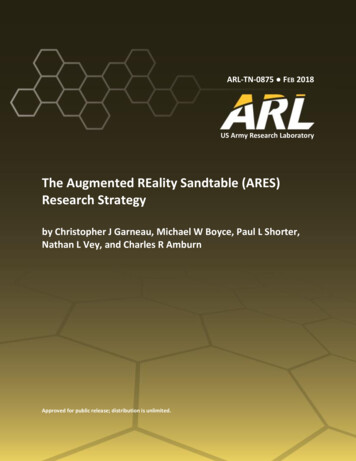
Transcription
ARL-TN-0875 FEB 2018US Army Research LaboratoryThe Augmented REality Sandtable (ARES)Research Strategyby Christopher J Garneau, Michael W Boyce, Paul L Shorter,Nathan L Vey, and Charles R AmburnApproved for public release; distribution is unlimited.
NOTICESDisclaimersThe findings in this report are not to be construed as an official Department of theArmy position unless so designated by other authorized documents.Citation of manufacturer’s or trade names does not constitute an officialendorsement or approval of the use thereof.Destroy this report when it is no longer needed. Do not return it to the originator.
ARL-TN-0875 FEB 2018US Army Research LaboratoryThe Augmented REality Sandtable (ARES)Research Strategyby Christopher J Garneau, Michael W Boyce, Paul L Shorter,Nathan L Vey, and Charles R AmburnHuman Research and Engineering Directorate, ARLApproved for public release; distribution is unlimited.
Form ApprovedOMB No. 0704-0188REPORT DOCUMENTATION PAGEPublic reporting burden for this collection of information is estimated to average 1 hour per response, including the time for reviewing instructions, searching existing data sources, gathering and maintaining thedata needed, and completing and reviewing the collection information. Send comments regarding this burden estimate or any other aspect of this collection of information, including suggestions for reducing theburden, to Department of Defense, Washington Headquarters Services, Directorate for Information Operations and Reports (0704-0188), 1215 Jefferson Davis Highway, Suite 1204, Arlington, VA 22202-4302.Respondents should be aware that notwithstanding any other provision of law, no person shall be subject to any penalty for failing to comply with a collection of information if it does not display a currentlyvalid OMB control number.PLEASE DO NOT RETURN YOUR FORM TO THE ABOVE ADDRESS.1. REPORT DATE (DD-MM-YYYY)2. REPORT TYPE3. DATES COVERED (From - To)February 2018Technical NoteFebruary 2015–November 20174. TITLE AND SUBTITLE5a. CONTRACT NUMBERThe Augmented REality Sandtable (ARES) Research Strategy5b. GRANT NUMBER5c. PROGRAM ELEMENT NUMBER6. AUTHOR(S)5d. PROJECT NUMBERChristopher J Garneau, Michael W Boyce, Paul L Shorter, Nathan L Vey, andCharles R Amburn5e. TASK NUMBER5f. WORK UNIT NUMBER7. PERFORMING ORGANIZATION NAME(S) AND ADDRESS(ES)8. PERFORMING ORGANIZATION REPORT NUMBERUS Army Research LaboratoryHuman Research and Engineering DirectorateATTN: RDRL-HRA-AAAberdeen Proving Ground, MD 21005-5068ARL-TN-08759. SPONSORING/MONITORING AGENCY NAME(S) AND ADDRESS(ES)10. SPONSOR/MONITOR'S ACRONYM(S)11. SPONSOR/MONITOR'S REPORT NUMBER(S)12. DISTRIBUTION/AVAILABILITY STATEMENTApproved for public release; distribution is unlimited.13. SUPPLEMENTARY NOTES14. ABSTRACTThe Augmented REality Sandtable (ARES) is a research and development testbed with the aim of determining theimprovements in battlespace visualization and decision-making that aid in providing a common operating picture at the pointof need and best meet user requirements. As a testbed for research, ARES is primarily concerned with human factors researchin the areas of information visualization, multimodal interaction, and human performance assessment. The purpose of thistechnical note is to discuss completed, ongoing, and planned research and provide an overall strategy for future work.15. SUBJECT TERMSAugmented REality Sandtable, battlespace visualization, simulation and training, information visualization, multimodalinteraction, human performance assessment16. SECURITY CLASSIFICATION OF:a. REPORTUnclassifiedb. ABSTRACTUnclassifiedc. THIS PAGEUnclassified17. LIMITATIONOFABSTRACT18. NUMBEROFPAGESUU3419a. NAME OF RESPONSIBLE PERSONChristopher J Garneau19b. TELEPHONE NUMBER (Include area code)(410) 278-5814Standard Form 298 (Rev. 8/98)Prescribed by ANSI Std. Z39.18ii
ContentsList of FiguresvList of Tablesv1.Introduction12.Research Questions and Areas for ARES Research22.1 ARES Motivation and Mission2.1.1 Improved Battlespace Visualization and Decision Making2.1.2 Common Operating Picture Defined by User Requirements2.1.3 Point of Need34552.2 Information Visualization Research Area52.3 Multimodal Interaction Research Area72.4 Human Performance Assessment Research Area92.5 Strategy for Establishing the Platform and Achieving Basic ResearchGoals113.Completed, Ongoing, and Planned ARES Research123.1 Completed Studies3.1.1 Study 1: Impact on Learning3.1.2 Study 2: Tactics (Pilot)3.1.3 Study 3: Tactics II121213143.2 Ongoing Studies3.2.1 Study 4: Chem-Bio Model Visualization3.2.2 Study 5: Cognitive Impact of Tangible AR3.2.3 Study 6: Time and Accuracy151515163.3 Planned Studies3.3.1 Study 7: Terrain Correlation Guidance3.3.2 Study 8: Floor Projection3.3.3 Study 9: Impact on Learning II: Expansion to AR/VR3.3.4 Study 10: Land Navigation3.3.5 Study 11: Distributed Collaboration161617171818Approved for public release; distribution is unlimited.iii
3.4 Summary194.Conclusion195.References20List of Symbols, Abbreviations, and Acronyms24Distribution List25Approved for public release; distribution is unlimited.iv
List of FiguresFig. 1ARES platform concept showing multiple modalities. 1Fig. 2ARES research strategy . 11List of TablesTable 1Completed, ongoing, and planned (short-term) ARES studies,organized by research area . 12Approved for public release; distribution is unlimited.v
INTENTIONALLY LEFT BLANK.Approved for public release; distribution is unlimited.vi
1.IntroductionThe Augmented REality Sandtable (ARES) is a research and development testbedwith the aim to improve battlespace visualization in order to provide a user-definedcommon operating picture at the point of need. As a physical platform, ARESconsists of several modalities, including but not limited to the following: A traditional sand table filled with play sand and supplemented withcommercial off-the-shelf components that allow the user to view andinteract with visual representations of an area of operations (AO) and relateddata. A mobile software application that provides an overview of the AO withgeospatial terrain data and additional layers of data for interaction andanalysis. An application that displays terrain and other data in the AO via mixedreality headsets (e.g., Microsoft HoloLens or HTC Vive).In addition to the various modalities, government-owned ARES software providesgeospatial terrain information and map images, tracks the sand topography, andallows users to build or edit tactical mission plans. The software serves the data toclient applications that then provide the data to users via one of the modalities.Figure 1 shows how the modalities work together in one ecosystem.Fig. 1ARES platform concept showing multiple modalitiesApproved for public release; distribution is unlimited.1
As a testbed for research, ARES is primarily concerned with human factors researchin the areas of information visualization, multimodal interaction, and humanperformance assessment. The purpose of this technical note is to discuss completed,ongoing, and planned research and provide an overall strategy for future research.In this context, “research” refers to activities conducted to gain insight into basic orapplied areas of inquiry related to ARES, as differentiated from the “research anddevelopment” required to expand the capabilities, supported analyses, or featuresof the ARES platform.A US Army Research Laboratory (ARL) special report was prepared in 2015 thatincludes a description of the ARES platform, relevance to the Army, similar effortsto date, existing and planned future capabilities, and discussion of many key leaderengagements (Amburn et al. 2015). While the 2015 ARES report included passingmention of research and evaluation activities, the present technical note insteaddelves deeper into the research activities. This document should not be viewed as acomprehensive agenda of work to be completed but is instead analogous to the workof an urban planner. In that domain, deliverables might include conceptualdrawings showing generic blocks with intended buildings or usages, but actualconstruction might substantially differ both in form and purpose. Similarly, ourplan is intended to summarize the work performed to date, project the regionswithin which research will be developed, and establish the predominant andsupplementary research questions that support future activities. However, this planis subject to change with changing requirements, new technological developments,or interest and/or funding for research with new use cases.2.Research Questions and Areas for ARES ResearchFundamentally, the predominant research question underlying all ARES researchactivities is the following: What improvements in battlespace visualization anddecision-making aid in providing a common operating picture at the point of needand best meet user requirements? The ARES platform brings together developmentin several areas to provide improvements to traditional means of battlespacevisualization, including: interactive displays; tangible user interfaces; andaugmented, virtual, and mixed reality. Each of these topics contributes to one of theresearch areas under investigation to provide advancements that help answer thepredominant research question above. These advancements may take the form ofimprovements to the ARES interface and interaction among modalities,development of other interface device(s), or generalizable research that answersimportant questions of interest, ultimately yielding new tools for Soldiers thatcontribute to Army readiness. This section addresses the predominant researchquestion, lanes of research, and an overall strategy for achieving research goals.Approved for public release; distribution is unlimited.2
2.1 ARES Motivation and MissionAn augmented reality sand table has the potential to enhance spatial awareness,improve visualization of the battlespace, increase engagement, enable distributedcollaboration, and save time when authoring 3-D terrains and scenarios (Amburnet al. 2015). Research for the ARES platform supports many of the following ArmyWarfighting Challenges (ACIC 2017): AWFC #1: Develop Situational Understanding AWFC #5: Counter Weapons of Mass Destruction AWFC #6: Conduct Homeland Operations AWFC #8: Enhance Realistic Training AWFC #9: Improve Soldier, Leader, and Team Performance AWFC #14: Ensure Interoperability and Operate in Joint, Interorganizational, Multi-national (JIM) Environment AWFC #15: Conduct Joint Combined Arms Maneuver AWFC #17/18: Employ Cross-Domain Fires AWFC #19: Exercise Mission CommandResearch for the ARES platform may also support the following ARL KeyCampaign Initiatives (KCIs), as identified in ARL’s Technical ImplementationPlan 2016–2020 (ARL 2016):Information Sciences Campaign KCI-IS-2: Taming the Flash-Floods of Networked Battlefield Information KCI-IS-3: Acting Intelligently in a Dynamic Battlefield of Information,Agents, and Humans KCI-IS-4: Sensing and Information Fusion for Advanced Indications andWarningsHuman Sciences Campaign KCI-HS-1: Robust Human and Machine Hybridization KCI-HS-2: Multi-faceted Assessment of Soldier Variability KCI-HS-3: Training Effectiveness ResearchApproved for public release; distribution is unlimited.3
ARES is certainly not the first augmented reality sand table; the 2015 ARES reporttabulated 25 efforts related to visualizing spatial data on virtual or sand tableinterfaces stretching back 20 years. The overwhelmingly positive reaction to ARESand the existence of various other virtual/augmented reality sand table research anddevelopment efforts bear testament to the great interest that exists in improvingtraditional means of visualizing and interacting with geospatial data relevant to thebattlespace.It is also important to emphasize that the ARES research program is not limited tospecific modalities (e.g., sand table). For instance, research might consider whetheran augmented reality projection on a wall with an interactive natural user interfaceenables new or different visualization, analysis, and decision-making capabilities.To address this consideration—and many others in this domain—it is helpful toconsider each part of the predominant research question for the ARES program.The following subsections address the 3 constituent components: improvedbattlespace visualization and decision making, common operating picture definedby user requirements, and point of need.2.1.1 Improved Battlespace Visualization and Decision MakingAdvancements in geospatial terrain visualization offer direct application to theARES platform. Many Geospatial Information System software suites offer theability to import terrain information and build graphical layers on top of the baselayer. However, these computer-based applications do not inherently offer a true3-D representation of the data as they are depicted on a 2-D computer monitor.Novel systems have begun to bring this data into 3-D space and combine it withintuitive user interfaces. For instance, Mitasova et al. (2012) discuss varioustechniques for constructing interactive 3-D multisurface visualizations withapplication to tangible environments; Fuhrmann et al. (2009) investigated the useof geospatial holograms for wayfinding and route planning for use by SpecialWeapons and Tactics (SWAT) teams. Providing additional layers of informationand analyses on top of the geospatial data enhances the ability of decision makersto make more informed decisions. For instance, additional visualization capabilitiesmight enable better perception of the terrain and dynamic presence of units and theemployed tactics. It is essential to conduct research on the human factors of suchimprovements to investigate their effect on the performance of decision makers andoptimize the presentation.Approved for public release; distribution is unlimited.4
2.1.2 Common Operating Picture Defined by User RequirementsA key characteristic of the ARES platform is the customizability and interactivityof the geospatial visualization. In other words, the platform enables decision makersto select the information that is relevant to them to create a picture of the battlespacethat supports decisions they have to make. Other literature refers to this as a UserDefined Common Operating Picture (UDOP). Mulgund and Landsman (2007)describe the UDOP operational concept and a prototype implementation; Hinikeret al. (2007) discuss plans to assess an interface designed with UDOP principles.Research should seek to better understand the types of information relevant tocertain classes of users, mechanisms for customizing the interface, and how best tointegrate the various data to present an enhanced common operating picture.2.1.3 Point of NeedThe point of need refers to the venue—both environment and setting—wheredecisions must be made or training needs to be conducted. An ideal decisionsupport tool easily adapts to varying points of need, whether in a classroom oroperational setting, or in a conference room or outdoor environment. The ARESsand table interface extends to both classroom and operational settings but is limitedto controlled indoor environments; the mobile and mixed reality interfaces offergreater portability but do not have a tangible component. Areas of research toconsider are how the platform can be extended to other environments, how variousmodalities may interact to better address adaptability/scalability to the point ofneed, and what the implications are for the overall value to the decision-maker.The following sections discuss each of the research areas that characterize ARESresearch activities.2.2 Information Visualization Research AreaThe critical question in information visualization is how best to transform data intosomething that people can understand for optimal decision-making (Ware 2012).ARES is fundamentally a system for visualizing a battlespace and providing toolsthat enable better decisions to be made. The information visualization research areainvestigates questions in this domain. In a military context, informationvisualization has been described as the cohesion of information characteristics andhuman cognitive processes that are embodied and situated by 2 requirements. Thefirst is battle command, which entails decision-making and visualizing the currentand future state of operations. The second is situational awareness, which entailsthe ability to identify, process, and comprehend the critical elements of informationabout what is happening (Ntuen 2009).Approved for public release; distribution is unlimited.5
Information visualization elevates the comprehension of information by fosteringrapid correlation and perceived associations (Livnat et al. 2005). The design of theinformation visualization platform must support the decision-making process,identifying and characterizing problems, and determining appropriate responses. Inthe context of research for the ARES platform, the area of greatest interest is thenexus of mixed reality and data visualization to ensure that optimization ofinformation visualization techniques for battle command and situational awarenessare incorporated. This inherently involves large datasets (e.g., geospatiallydistributed model outputs).Research conducted in this area has explored information visualization in specificcontexts (e.g., battlespace visualization), the use of multiple views to visuallyconvey information (Baldonado et al. 2000), and situational awareness for decisionmaking. In addition, other research has attempted to support informationvisualization research and development by creating a taxonomy to codify humanperceptual and cognitive capabilities and limitations, independent of domain,thereby providing a means to empirically assess and compare research outcomes(Pfitzner et al. 2001). Colleagues at ARL are also conducting research ininformation visualization that may be relevant to the ARES platform (e.g., Chen2005; Chen et al. 2014; Hansberger 2015); any future efforts in similar topicsshould first consult these or other ARL researchers to gain insight on lessonslearned or points for collaboration.Research questions of interest may include the following: Can a defined taxonomy help delineate various factors in battlespacevisualization that will serve to assist in evaluating and assessing theeffectiveness of ARES? How would using various information visualization techniques in adistributed environment affect team performance? How do various information visualization implementations affectperformance on tasks related to battlespace visualization and what types oftasks or scenarios are best suited to the various implementations? How might various information visualization techniques help usersvisualize interactions with intelligent agents in the battlespace and improvehuman–agent teaming? Do users benefit from controlling the amount and type of informationpresented to them on ARES?Approved for public release; distribution is unlimited.6
Do various components of the ARES platform enhance users’ situationalawareness, and to what extent? What are the limits of visual perception that are necessary to allow users toperceive terrain features (e.g., should a hill be 3 inches or 12 inches toprovide maximum situational awareness)? Do the same information visualization techniques apply across the ARESmodalities (i.e., sand table, mobile tablet, and mixed reality headset)? Do some users learn better with using a real 3-D display than with virtual3-D or 2-D/printed maps?Information visualization research should be formulated in the context of how itrelates to battle command doctrine, situational awareness, and developing ataxonomy in which to work.2.3 Multimodal Interaction Research AreaA goal of the ARES program—reflected in the predominant research question—isto provide decision makers with battlespace visualization tools at the point of need.ARES accomplishes this via the use of virtual, augmented, or mixed reality inmultiple modalities (Fig. 1). The multimodal interaction research area is concernedwith how various modalities moderate the experience and affect user performance.Until very recently, ARES has relied primarily on a single visual-tactile interface(i.e., the sand table); future research should consider the interaction among multipleinterfaces that may also include other new modalities (e.g., gestures, auditory cues,voice commands).Multimodal interfaces may be characterized as systems that respond to inputs inmore than one modality or communication channel—for instance, speech, gesture,writing, touch, etc. (Jaimes and Sebe 2007). As a broad area of research,multimodal interaction seeks to research and develop technologies, methods, andinterfaces that make full use of human capabilities to interface with a system. Turk(2014) provides a good review of relevant literature in this area. Multimodalintegration is an area ripe for exploration—better understanding individualmodalities, how and when to integrate multiple channels in models, and exploringthe full range of modality combinations are all research challenges.Many examples in the literature have explored different modes of interacting withinformation using nonconventional displays that are directly applicable to themodalities employed by the ARES platform, including 1) interactive tabletops (e.g.,Annett et al. 2011; Alnusayri 2015), 2) tangible user interfaces (e.g., Ishii 2008;Approved for public release; distribution is unlimited.7
Maquil 2016), and 3) augmented reality and holograms (e.g., Fuhrmann et al.2009). For these types of interfaces, an important consideration is that usersappropriately tailor displays to the task at hand and select an appropriate level ofdetail for their interaction—factors that should be assessed empirically (Hegarty etal. 2012). Large-format interfaces—for instance, interactive tabletops (Maldonado2014) or projector-based augmented reality (Marner et al. 2014)—often facilitatecollaboration. Tangible user interfaces may facilitate inquiry but may not lead tomore thorough interaction or deeper questions about the content (Ma et al. 2015),though when used for learning may yield greater learning gain (Schneider et al.2011). Voice command and auditory feedback—perhaps in the form of a naturallanguage interface—present another avenue for interaction in the ARES ecosystemthat should also be explored in future research. As with the informationvisualization research area, there are at least a few colleagues at ARL who are alsoconducting research in various types of (and combinations of) interfaces that maybe relevant to the ARES platform (e.g., Elliott et al. 2009; Myles and Kalb 2015).Researchers working on future efforts in similar areas should remain vigilant forlessons learned or points of collaboration.Some sample research questions of interest to the ARES program in this researcharea include the following: What are the benefits and drawbacks to the user of various types ofinterfaces (e.g., sand table, mobile tablet, and mixed reality headsets)? Does the use case affect user performance for the various modalities? How might each interface and its mode of interaction affect users’ ability tovisualize and fuse information coming from a multitude of sensors and datasources to efficiently make decisions? Can users interact with ARES without the use of peripheral devices (i.e.,using gestures) and what benefit does this type of interaction provide? Do some users perform better using a tangible user interface? Does touching or shaping the sand matter? What do the findings portend for other systems that may benefit from tactilefeedback? How does user and team performance using a distributed multiple-modalitysystem compare with a distributed single-modality system?Generally, research questions in this area should be formulated to characterize 1)factors moderating the experience between a user and an interface, 2) the quality ofApproved for public release; distribution is unlimited.8
analysis or overall performance of a user as a function of a chosen modality, and/or3) individual and/or team performance given a system with multiple modalitiesand/or multiple users.2.4 Human Performance Assessment Research AreaThe predominant research question for ARES specifies that tools developed by theplatform to enhance decision-making attempt to best meet its users’ requirements.Thus, there exists the need to accurately model human performance for any newmodalities or information visualization techniques employed by the platform.Correctly understanding human performance can assist in explaining humanvariability (Szalma 2009) and sources of human error, and provide predictions fortask outcomes and the behaviors preceding them. Successful performance on a taskrequires a certain degree of precision. Humans are susceptible to internal andexternal factors that cause them to be imprecise. Examples of these factors includeaptitude, existing knowledge, stress, and time pressure (DOE 2009).The human performance assessment research area facilitates alignment of systemparameters and capabilities with human preferences and abilities while operatingin complex environments. This allows for the customization of interfaces that yieldoptimal performance.The literature suggests many different approaches for modeling humanperformance. The effective analysis of human performance requires sufficientgranularity in the level of detail associated with each human interaction.Quantitative and qualitative methods must capture this detail to ensure scientificvalidity. Of specific emphasis to ARES is the relationship between the human andthe system.Human performance assessment tends to fall under 3 specific areas: 1) perceptionand attention allocation, 2) command and control, and 3) cognition and memory(Byrne and Pew 2009). Within attention and perception are human factorsfundamentals such as signal detection theory (i.e., does a stimulus provide enoughinformation to distinguish a target amongst distractors?), visual search, andmultitasking (Laughery et al. 2012). Command and control relies on the ability toselect information in an efficient and effective manner (e.g., the Hick–Hyman lawfor choice response time [Hick 1952; Hyman 1953] and the observe, orient, decide,and act [OODA] loop to model associated actions [Gooley and McKneely 2012]).Cognition and memory consists of the understanding of acquiring skills andexpertise (i.e., cognitive skill acquisition), the interpretation and aggregation ofpresented information (i.e., situation awareness), and decision-making as it isApproved for public release; distribution is unlimited.9
related to ARES users (e.g., military decision-making process) (Lickteig et al.1998).Potential human performance assessment research questions relevant to the ARESprogram include the following: Can augmented reality capabilities increase performance on tasks related tobattlespace visualization? To what extent does augmented reality increase performance metrics (e.g.,accuracy, time on task, situational awareness) and what types of tasks orscenarios most benefit from its use? Can the ARES platform effectively instruct students through one-to-one orone-to-many methods (e.g., virtual avatars, intelligent tutors, videoteleconferences)? Do certain users’ spatial abilities make a difference? Are there differences in the amount of information users retain acrossvarious modalities (e.g., PowerPoint, topographical map, traditional sandtable, various ARES modalities)? What are the generalizable performance predictors across tasks as users areinteracting with ARES? How do individual difference factors such as self-efficacy, motivation, andpersonality mediate or moderate performance outcomes? How do the metrics associated with individual human performanceassessment transfer to collaborative learning or team performanceassessment associated with ARES interaction? What standardized human performance metrics can individual researchersusing ARES technologies measure to ensure the ability to compare acrossexperiments? How is human error represented within ARES technology interaction (i.e.,active errors compared to latent errors and slips compared to mistakes)?Research efforts in human performance assessment will also need to focus onaddressing both the strengths and weaknesses of assessment. Strengths includespecificity, clarity, and objectivity, while weaknesses include generalizability,validity, and confounding variables (Byrne and Pew 2009; Creswell 2014). Themanagement of these potential dimensions will rely on a combination of designingto Soldier requirements while ensuring soundness of empirical rigor.Approved for public release; distribution is unlimited.10
2.5 Strategy for Establishing the Platform and Achieving BasicResearch GoalsThe 3 research areas all share a common thread: how best to enable the human userto view and interact with content/information so that they can better understand theinformation; communicate with peers, supervisors, and subordinates; and makebetter and faster decisions. A challenge in crafting any research strategy for a newproduct or platform is appropriately scoping the research, demonstrating the valueof the platform while simultaneously performing basic and applied research that isrelevant beyond the platform. To resolve pressing immediate questions, an effectivestrategy might first ask, “Is this worth doing?”, “Do users like and respond betterto this interface or technique?”, and “Is performance better than what alreadyexists?” Once the value of the platform is established, follow-up research shouldask more focused, basic research questions of interest to the greater scientificcommunity that also yield insight to improve
The Augmented REality Sandtable (ARES) is a research and development testbed with the aim of determining the improvements in battlespace visualization and decision-making that aid in providing a common operating pict
